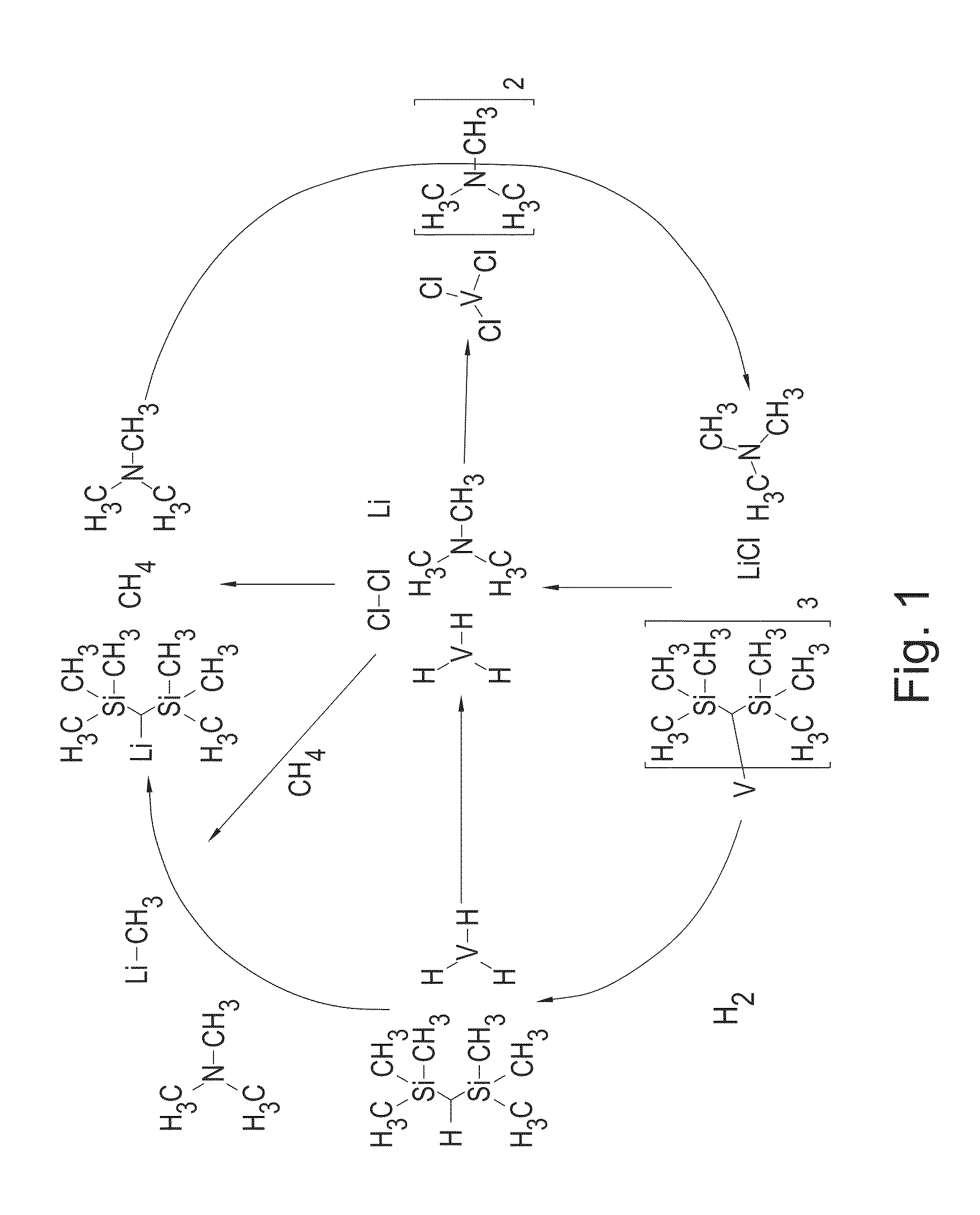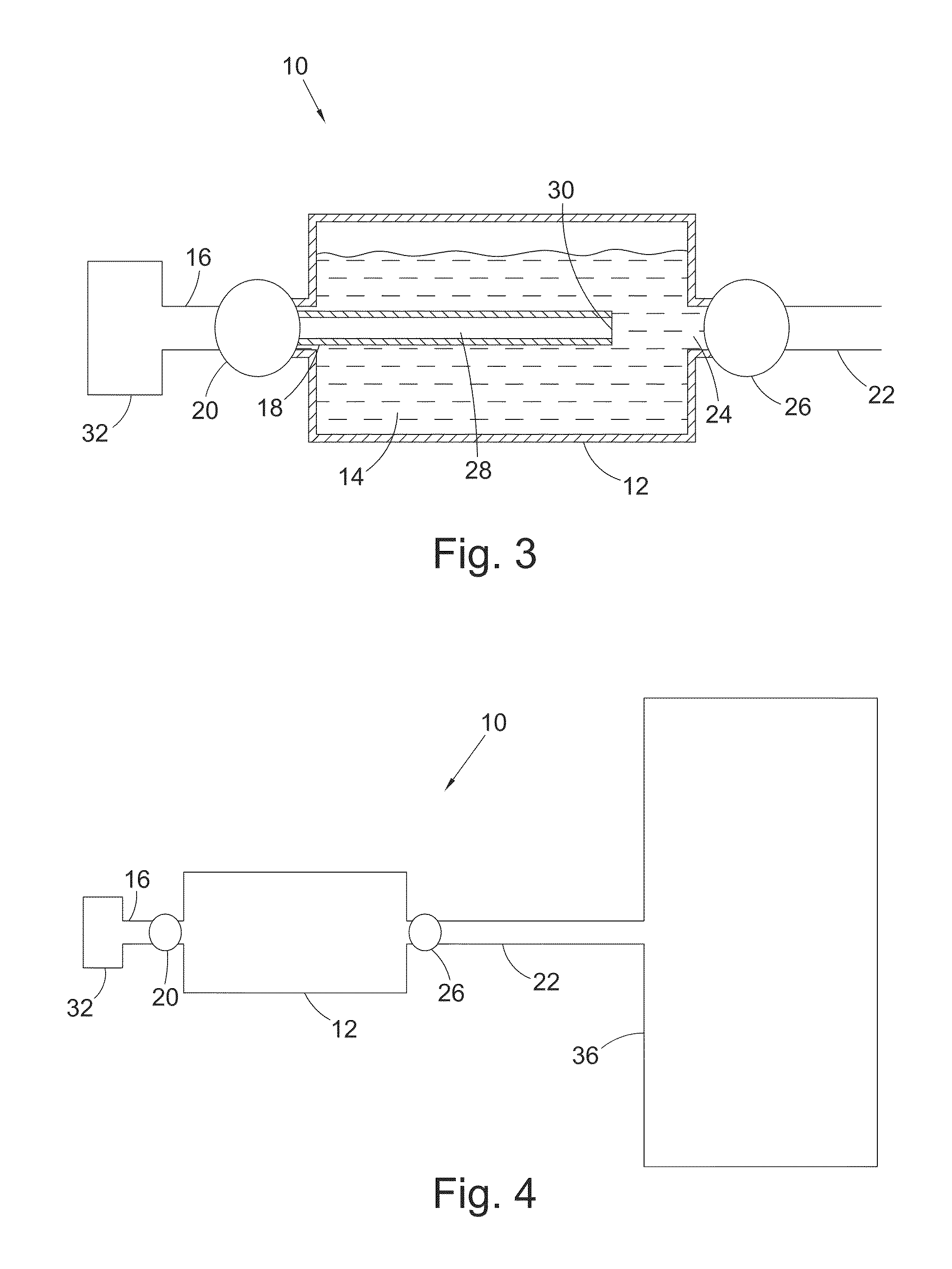Novel Metal Hydrides And Their Use In Hydrogen Storage Applications
- Summary
- Abstract
- Description
- Claims
- Application Information
AI Technical Summary
Benefits of technology
Problems solved by technology
Method used
Image
Examples
example 1
Example 1a
VH3
Synthesis
[0294]Bis(trimethylsilyl)methyl lithium (0.9260 g, 5.57 mmol) in 50 mL of diethyl ether was added dropwise to a dark purple suspension of VCl3(NEt3)0.78 (0.4384 g, 1.856 mmol) at 298 K. The reaction mixture turned dark green. The reaction was stirred for three hours then all the volatiles were removed in vacuo (10−3 torr). The green / brown oil was extracted with 50 mL of 40-60° C. petroleum ether and filtered to afford a light precipitate and brown solution. The solution was concentrated and dried in vacuo (10−3 torr) overnight to afford V(CH(SiMe3)2)3 as a brown oil.
[0295]50 ml of toluene was added to 0.4164 g (1.85 mmol) of V (CH(SiMe3)2)3 and the mixture was stirred to afford a dark green / brown solution. Hydrogen gas grade 6.0 was bubbled through the solution at room temperature. The color changed to black over 24 hours, during which time black particles may precipitate. The toluene was removed and the resulting black solid was dried ...
example 1b
VH3
Synthesis
[0306]Bis(trimethylsilyl)methyl lithium (4.2805 g, 25.76 mmol) in 50 mL of diethyl ether was added dropwise to a dark purple suspension of VCl3(NEt3)0.78 (2.0292 g, 8.59 mmol) at 298 K. The reaction mixture turned dark green. The reaction was stirred for three hours then volatiles were removed in vacuo (10−3 torr). The resulting green / brown oil was extracted with 50 mL of 40-60° C. petroleum ether and filtered to afford a light precipitate and a brown solution. The solution was concentrated and dried in vacuo (10−3 torr) for two hours to afford tris[bis(trimethylsilyl)methyl]vanadium (III) as a brown oil.
[0307]Tris[bis(trimethylsilyl)methyl]vanadium (III) in 50 mL of toluene was stirred under hydrogen gas for 5 days. A small amount of dark brown precipitate formed. The toluene was removed and the resulting dark brown solid was dried in vacuo (10−3 torr) at 100° C. for four hours to afford a black solid. The black solid was then transferred to a stainless steel sample ho...
example 1c
VH4
Synthesis
[0313]Phenyllithium (51.24 mmol, 25.62 mL of a 2.0M solution in dibutylether) was stirred at room temperature. VCl4 (2.47 g, 12.81 mmol) was added dropwise via a syringe. The reaction mixture turned dark brown in colour, increased in temperature and bubbled vigorously. The reaction was stirred for fifteen minutes until the bubbling had subsided and the mixture had cooled back to room temperature. The mixture was then filtered to afford a dark brown precipitate and a brown filtrate. The filtrate was immediately transferred to a Schlenk flask and stirred under 1 bar of hydrogen gas for a total of 12 days (7 days at 298 K followed by 5 days at 80° C.). The mixture was then filtered to afford a black precipitate. The precipitate was dried in vacuo (10−3 torr) for four hours at 100° C. to afford sample VB-100 as a fine black powder (1.25 g).
[0314]Sample VB-100 was further hydrogenated at a pressure of 85 bar for two hours at 100° C. The resulting material was then dried in v...
PUM
| Property | Measurement | Unit |
|---|---|---|
| Fraction | aaaaa | aaaaa |
| Specific surface area | aaaaa | aaaaa |
| Specific surface area | aaaaa | aaaaa |
Abstract
Description
Claims
Application Information
 Login to View More
Login to View More - R&D
- Intellectual Property
- Life Sciences
- Materials
- Tech Scout
- Unparalleled Data Quality
- Higher Quality Content
- 60% Fewer Hallucinations
Browse by: Latest US Patents, China's latest patents, Technical Efficacy Thesaurus, Application Domain, Technology Topic, Popular Technical Reports.
© 2025 PatSnap. All rights reserved.Legal|Privacy policy|Modern Slavery Act Transparency Statement|Sitemap|About US| Contact US: help@patsnap.com



